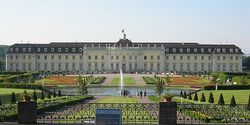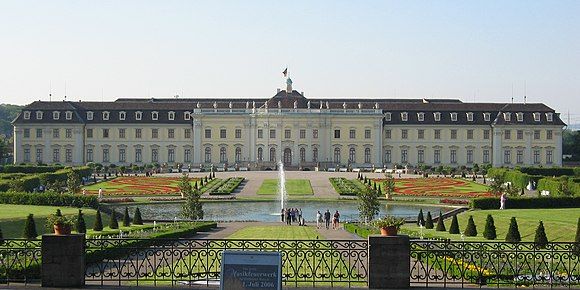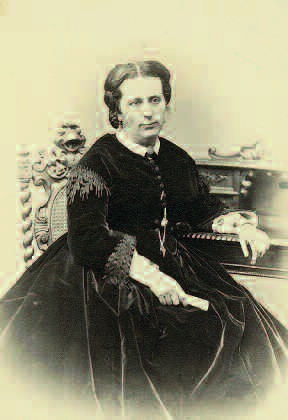In 1841, her uncle, Honoré V (1778–1841), the reigning prince, died without a legitimate descendant, and so Florestine's father acceded to the throne.
In the early 1860s, as she approached her thirtieth birthday, Florestine met Count Wilhelm of Württemberg (1810–1869), who hailed from a non-dynastic branch of the Württemberg royal family.A widower and the father of four young girls, he was visiting the Riviera in the hope that the sea air would be beneficial to one of his daughters, Marie, who was consumptive. He was described by the Journal de Monaco as "one of the most distinguished generals of the German Confederation, he is also a learned archaeologist and an informed arts enthusiast." Florestine married Wilhelm in 1863 at the Prince's Palace, enabling the Grimaldi family to forge a union with a royal house.
Florestine settled in Stuttgart, the capital of the Kingdom of Württemberg. She rapidly became part of the court, where she displayed exceptional social skills, though she retained a strong link with the Principality. It was in Monaco that her sick stepdaughter, Marie, died in 1864, and that the couple's first child, Wilhelm Charles Florestan Gero Crescentius, was born. A younger brother, Charles Joseph Florestan Gero Crescentius, was born at Ulm Palace in 1865. In 1867, Wilhelm and Florestine were given the title Duke and Duchess of Urach, which was created for them by King Charles I of Württemberg.
Florestine was not spared tragedy. Another stepdaughter, Eugenia, died prematurely in 1867. Her husband, who was also sick, then converted to Catholicism, and died two years later.The widowed Duchess of Urach continued to split her time between Germany, the Château de Marchais and Monaco. When she was there, she assumed an important role in the life of the Monegasque court and assisted her brother, who had become increasingly blind due to severe attacks of neuralgia. Her two children, Wilhelm and Charles, were sent to board at the Collège de la Visitation in Monaco, where they received their first communions in 1875 and 1876. The alliance between Florestine and Württemberg had significant political repercussions when, in the absence of a legitimate descendent of Prince Louis, Charles III's grandson, in the early twentieth century, Florestine's eldest son Wilhelm was the presumptive heir to the Throne of Monaco. This situation, which raised concerns in France due to the risk of Germany gaining control of the Principality, turned into a dynastic struggle. In 1911, Charlotte, the illegitimate daughter of Prince Louis, was recognised as part of the line of succession, to the great displeasure of the Urachs. Having been legitimised by her grandfather Albert I, Charlotte was officially adopted by Louis in 1919, in the presence of the President of the French Republic.France had undergone two wars against Germany and did not wish to see German princes ruling the in Monaco. Charlotte renounced and ceded her rights to the princely throne on 30 May 1944 to her son Rainier who became Rainier III, Prince of Monaco.
In 1841, her uncle, Honoré V (1778–1841), the reigning prince, died without a legitimate descendant, and so Florestine's father acceded to the throne.
In the early 1860s, as she approached her thirtieth birthday, Florestine met Count Wilhelm of Württemberg (1810–1869), who hailed from a non-dynastic branch of the Württemberg royal family.A widower and the father of four young girls, he was visiting the Riviera in the hope that the sea air would be beneficial to one of his daughters, Marie, who was consumptive. He was described by the Journal de Monaco as "one of the most distinguished generals of the German Confederation, he is also a learned archaeologist and an informed arts enthusiast." Florestine married Wilhelm in 1863 at the Prince's Palace, enabling the Grimaldi family to forge a union with a royal house.
Florestine settled in Stuttgart, the capital of the Kingdom of Württemberg. She rapidly became part of the court, where she displayed exceptional social skills, though she retained a strong link with the Principality. It was in Monaco that her sick stepdaughter, Marie, died in 1864, and that the couple's first child, Wilhelm Charles Florestan Gero Crescentius, was born. A younger brother, Charles Joseph Florestan Gero Crescentius, was born at Ulm Palace in 1865. In 1867, Wilhelm and Florestine were given the title Duke and Duchess of Urach, which was created for them by King Charles I of Württemberg.
Florestine was not spared tragedy. Another stepdaughter, Eugenia, died prematurely in 1867. Her husband, who was also sick, then converted to Catholicism, and died two years later.The widowed Duchess of Urach continued to split her time between Germany, the Château de Marchais and Monaco. When she was there, she assumed an important role in the life of the Monegasque court and assisted her brother, who had become increasingly blind due to severe attacks of neuralgia. Her two children, Wilhelm and Charles, were sent to board at the Collège de la Visitation in Monaco, where they received their first communions in 1875 and 1876. The alliance between Florestine and Württemberg had significant political repercussions when, in the absence of a legitimate descendent of Prince Louis, Charles III's grandson, in the early twentieth century, Florestine's eldest son Wilhelm was the presumptive heir to the Throne of Monaco. This situation, which raised concerns in France due to the risk of Germany gaining control of the Principality, turned into a dynastic struggle. In 1911, Charlotte, the illegitimate daughter of Prince Louis, was recognised as part of the line of succession, to the great displeasure of the Urachs. Having been legitimised by her grandfather Albert I, Charlotte was officially adopted by Louis in 1919, in the presence of the President of the French Republic.France had undergone two wars against Germany and did not wish to see German princes ruling the in Monaco. Charlotte renounced and ceded her rights to the princely throne on 30 May 1944 to her son Rainier who became Rainier III, Prince of Monaco.
Family Members
Advertisement
Records on Ancestry
Sponsored by Ancestry
Advertisement








